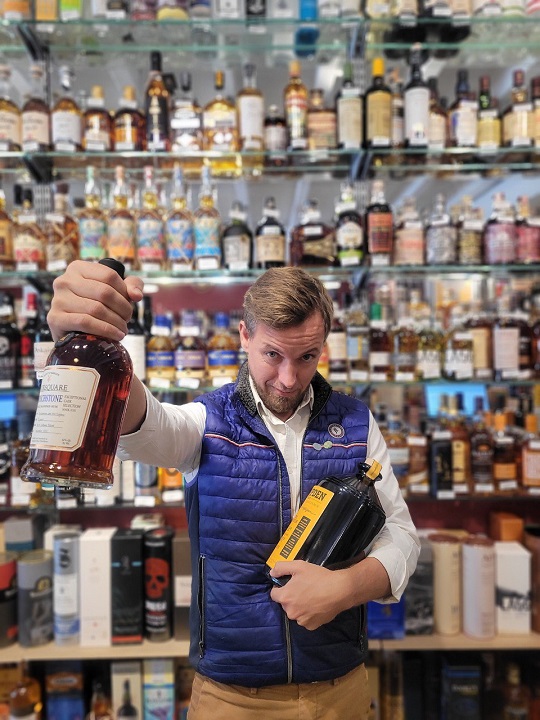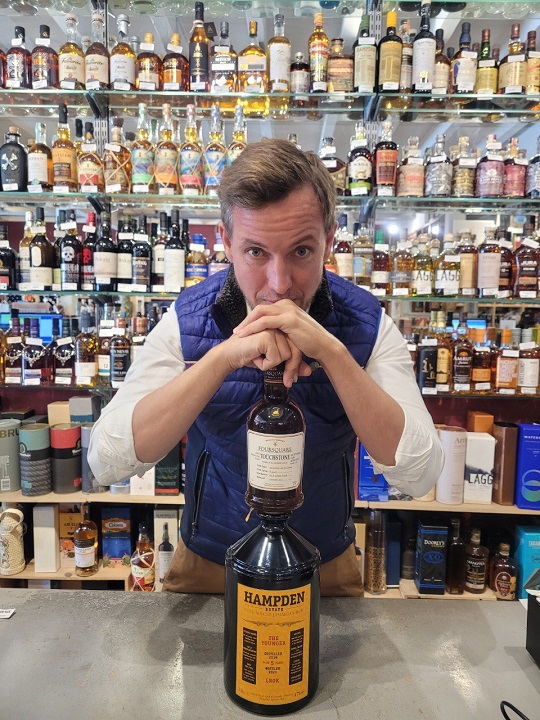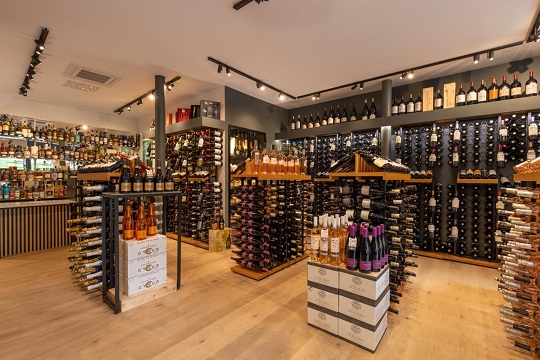Super Early Bird Ends
30 April 2025
Warehouse Deadline
30 Sep 2025
Judging Dates
7 October 2025
Winners Announcement
28 October 2025

Fine Wine and Spirits Consultant, Adam Barley is an ardent promoter of French wine and a devoted advocate of New World wines. Starting his journey as an IT manager, he is currently the Sommelier-Caviste at CAVAVIN Au Bon Caviste in France. Read all about his journey below.
Hello there, my name’s Adam Barley. I’m a 37-year-old Franco-British fine wine and spirits merchant working in a wine shop on the outskirts of Toulon, in the south-east of France. I graduated from Aston University, Birmingham UK, in 2004 with a combined honours Bachelor’s degree in computer science and human psychology. I worked in IT for a number of years in Cannes before being introduced to the world of fine wines around 2012. I took the decision to leave IT for wine in 2016, and haven’t looked back since. In 2018, I became a certified Sommelier-Caviste by the Université du Vin de Suze-la-Rousse, near Chateauneuf-du-Pape and I have acquired considerable experience at all echelons of the wine world, dabbling in everything from vine pruning to harvesting and winemaking, as wells as sales, oenotourism and even teaching about wine. My main focus remains the commercial aspect, and notably the end-user, or final customer, experience.
I’ve developed considerable interest in spirits! In March 2022, I was trained in Cognac to distil gin and vodka, and I have recently obtained my WSET Spirits level 3 certification.

Unfortunately, my new world/old world wine love life is totally out of balance. As much as I’d love to be able to enjoy more new world wines, they are relatively hard to come by in France. I was lucky enough to bring a few bottles back from my travels abroad, so I’ll very happily crack one open when the occasion deserves it! It is possible to find some very good new world wines in France, but their relatively high price point (when compared to readily available French wines) does mean that they’re not accessible to the greater public. The only trick I can think of to enjoy new world wines to their much deserved fullest, is to hop on a plane and get over there!
Adventure and wine! I had longed to travel to Oceania for many years, and when the opportunity presented itself, I had to seize it. I spent a year in each country, alternating work with exploration. I was able to work in wine shops that gave me the means to taste and learn all about the local wines, while also improving my general wine skills and knowledge.
I’ve recently had the privilege to pass WSET 3 in both wine and spirits. The WSET 3 in spirits was a real eye opener; it is the most advanced course currently available in the world to explore spirits by studying the intricate details of their elaboration, and of course the nuances and styles of the finished product. The course has indeed boosted my confidence considerably, but it has also given me the means to explain spirits in more detail and pass on my knowledge more effectively to my customers and colleagues.
In regards to the WSET 3 in wines, I really enjoyed its interpretation of ‘terroir’; it is very thorough in explaining the influence of topology, climate, geology, viticulture and vinification on the quality and style of a wine, but also how it justifies its RRP. The WSET 3 in wines skims over a lot of things that I assume are treated in the DipWSET; it really succeeds in stimulating a thirst for knowledge!

Practice, practice, practice. Even before I started any kind of formal training, I was tasting hundreds of wines whenever I had the chance. Be it in New-Zealand, or in France, I did a lot of research into the wines I was tasting, I would visit vineyards, discuss wine with my peers, may they be winemakers or wine merchants, and just seize any opportunity that was wine-related. There is so much to learn from visiting wineries, and if time allows it, the professionals working there are more than happy to share their knowledge with you.
The Université du Vin was an incredible experience. It was a short but very intense four month training period. The course I followed goes into considerable depth in all wine-related domains, but really accentuates developing a detailed wine tasting and analysis technique. We tasted 15 to 20 wines per day over a two-month period, and the teachers expected a lot of detail from us. When compared with WSET 3, a lot more information was expected from us when tasting wine. We were taught how to analyse wine in an empirical fashion, while also being able to actively comment a wine in a more commercial setting with vocabulary better suited to a wider public. Also, wine and food-pairings were explored and discussed to a greater extent.
We’re lucky to have quite a large range of wines here. We are one of the biggest, if not THE biggest, shop in the Cavavin network. Being situated in the heart of Provence, approximately 25% of our wines are local; they also account for the majority of our wine sales. Our customer-base is principally French, and they are very attached to consuming French wine. That being said, we are actively working on expanding our Wines of the World section; our greatest challenges are finding quality wines at a reasonable price and convincing our customers to leave their comfort zone.
Most Cavavin wine shops are independent, but have to meet a defined quota of wines purchased from the Cavavin distribution platform. About 30% of our wines are selected from that platform. The wines that make up the remaining 70% are totally up to us. We are quite limited in the amount of time we can spend chasing up new wineries, so we are somewhat dependant on commercial agents that distribute wine on the behalf of wineries. We are a team of four, shop owner included; any wine that enters our shop is tasted and discussed by us all. The owner has the final word, but he relies on the competence and experience of his employees, so a general consensus is usually required for a wine to reach our shelves.
We tend to privilege long-standing relationships with wineries to promote a healthy work ethic and good relations. We will however taste every new vintage to ensure that it continues to meet our standards, and of course match the quality of previous vintages. Nonetheless, we also try to create a dynamic environment, so we’re always on the lookout for new wines to surprise our customers with.
Well, first things first, never judge a book by its cover! When a new customer, or any customer in fact, enters our shop, we will hunt down some basic information about what they’re looking for. What’s the occasion; gift or consumption? Is the wine going to be paired with a specific dish? Budget? Are they after something local? We will also attempt to accommodate their personal preferences, but answers to these questions will help us pinpoint the perfect wine for the occasion.
As we’re asking these questions, we will draw up a customer profile that will help us convince the client and conclude the sale. Some customers are insecure, and will require a well-known wine or appellation. Others refuse to leave their comfort zone and will only accept something they’ve already tasted, or a wine that they assume to be good. Some customers require the wine to meet a specific budget, be it high or low.
Answers to these questions aren’t always easy to come by; customers either lack the words to precisely express what they’re after, or they’re unwilling to openly do so. The latter is predominantly the case in regards to budget. It’s therefore up to us to attempt to set the boundaries, and test the limits. No budget? No problem, we have wines worth hundreds of euros. Oh, the customer isn’t fussed about triple digit wines? Let’s keep going.

As mentioned above, the customer profile will give us the tools to upsell a product, be it wine or anything else really. Some the tactics we can use are as follows.
Novelty: We have customers that visit us on a regular basis, and often purchase the same selection of wines or products. Some of these customers might have tasted more of our store’s wines or spirits than ourselves! Proposing a novelty, a product that is unusual or that we’ve never had in-store before, which granted might be a little more expensive than their usual, can lead to an extra sale. This can lead to a potential expansion or increase in value of their regular consumption.
Upgrade: Once we’ve identified the customer’s needs, we can upsell by conceding that we’ve surpassed the budget, but accentuate meeting and exceeding all other needs. Wineries and distilleries can facilitate an upsell for us by proposing multiple products at a different price range. We can argue a “Try this, it’s better” approach, which is simple, but works. When the sale is reinforced by a growth system, or cask strength for example, the upsell is generally assured. “I’ve already practically sold this to you, but you might want to try this product that is from a better vineyard, undiluted, aged in better casks, etc.”
Emotion: A fine bottle of wine, or a spirit, is often purchased for a special occasion. Whether or not the product is to be consumed or offered as a gift, it is possible to upsell by accentuating the importance of the occasion. This again comes down to knowing your client, and enquiring about the occasion in question.
Rarity: Often linked to the upgrade tactic, rarity is an argument that we can use to upsell a bottle. “For a limited time only”, we’ve all heard that before. Some wine and spirits that we are able to get our hands on are seriously limited in quantity. Some of our best wines are under allocation, and our spirits can be limited to one or two bottles per year. Discussing this openly with our customer can seal the deal.
It is important to keep in mind that these tactics are used in order to attain a win-win situation. We’re looking to increase sales and profits, but our priority and end goal remains customer satisfaction and high fidelity. If we upsell a bottle that doesn’t match our customer’s needs, they will most likely not be coming back.
As mentioned above, many of our upsell tactics serve also as a strategy to ensure fidelity. We are looking out for our customers and ensuring that they purchase the best bottle to match their needs. For long term regular customers, we have a fidelity system that offers a one-time discount after having spent so much. We will also sometimes give a regular customer a free bottle as a gift, or invite them to a tasting. This helps entertain fidelity while also creating an opportunity for an upsell at a later occasion.
The concept behind the oenological signs is to ask the customer a series of questions after a blind tasting, and depending on their answers, assign to them an oenological sign inspired by the astrological. Although Cavavin is a network of shops that benefit from a common image and a centralized buying platform, each shop retains some degree of independence. We chose not to propose the oenological signs. Although it is a fun approach to wine tasting, we find it rather restrictive and reductive in regard to the vastness and complexity of wine. We would much rather encourage our customers to rely on the expert knowledge of our sales reps that are trained to advise the customer.
During the summer, we will organise wine tasting on a weekly basis. We will invite one of the winemakers we work with to the store so that he may present his wines to our customers. We privilege local winemakers for their proximity; local wine is also the category that we sell the most of, so it makes sense. We will communicate on these tastings in-store via displays and verbally, and also on our social networks. They usually take place on Fridays when many of our customers pop in to stock up for the weekend or to relax after a week’s work.
We have also succeeded in being widely-regarded as one of the best spirits shops in the area. This is due to our very large spirits selection, our highly-qualified staff, and the masterclasses that we organise on a regular basis. Outside of the summer period and Christmas, we will organise one to two masterclasses per month, generally rum or whisky. The masterclass is usually based around a theme such as a single distillery, or a country, and we’ll have a brand ambassador or representative from the distillery to animate the class. For example, we were lucky to have Mark Reynier with us earlier this year!
We have no problem filling our masterclasses. Our customers are as passionate about spirits as we are, and we have a considerable focused mailing list at our disposal for quick and easy communication with them.
There are many sources worth following! I try to diversify; for wine info, I’ll regularly check the big boys, such as La Revue des Vins de France, WineSpectator, Decanter, and The WineAdvocate, while also receiving newsletters from Vitisphere, and le Rouge et le Blanc. I am happy to follow many winemakers and distributors on LinkedIn that provide additional insight. Regarding spirits, I’ll often follow websites such as WhiskyMag, Distilnews, Rumporter and Punchdrink. We also receive insider information directly from our suppliers such as LMDW and Dugas, and on a more personal level, I enjoy reading articles shared by Richard Seal, Mark Reynier, Gregg Glass, etc.
I also highly recommend a number of podcasts such as I’ll Drink to That, Distilcast, GuildSomm, Spirits Distilled, Wine for Normal People, etc.
Interview by Stuti Khetan, Beverage Trade Network